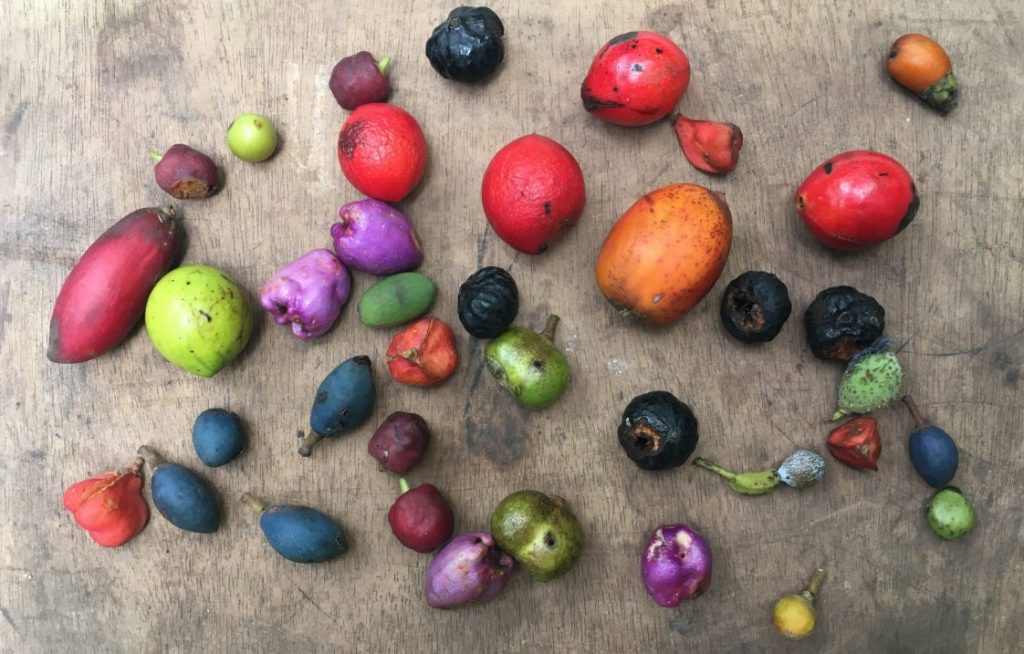I am sure all of us have had a good feed of tropical fruit over the Christmas-New Year period but I doubt that this included any of the fruit which is currently scattered along our local walking tracks. This food is vitally important to local birds and mammals as well as insects, and some of it is edible and would have been highly valued by traditional owners of the forests. During two walks over the holidays (one by my daughter Carla and her partner Michael out behind the dam just after Christmas, and the other by me along the H-track this Sunday past) it was possible to accumulate a pretty diverse and colourful assortment of fruit. I thought I would share the photos since the colours and shapes are are visually stunning.


Since retiring I have been sporadically collecting fruit during my walks and looking them up in the rainforest fruit “Bible”1. This has enabled me to make a guess at the names of around a dozen of what I reckon is 20 different species between the two platters displayed here. I know that some of these are edible, but others may not be so please do not experiment with any fruit you find in the forest unless you are absolutely sure of your identification and your knowledge of edibility.
Here is the list of trees whose fruit I have tentatively identified in the photos.
- Paperbark Satinash (Syzygium paparaceum)
- Silver Ash (Flindersia bourjotiana)
- Grey Carrabeen (Sloanea mcbrydei)
- Small leaved Fig (Ficus obliqua) a strangler fig
- Silky Tamarind (Guioa lasionerua)
- Hickory boxwood (Planchonella euphlebia)
- Synima (Synima cordierorum)
- Bleeding Heart (Homalanthus novo-guineensis)
- Powderpuff Lilli Pilly (Syzygium wilsonii)
- Quandong (Elaeocarpus sp – foveolatus?)
- Black Pine (Prumnopitys amara)
- Jitta (Halfordia kendack)
- Cinnamon Laurel (Cryptocarpa densiflora)
If anyone has any other names to suggest please leave a comment!
Text and photos by Jamie Oliver
1Cooper & Cooper (2004). Fruits of the Australian Tropical Rainforest. Nokomis Editions, Melbourne

Hi Jamie, I couldn’t help but notice that your collection of summer fruits includes seeds from the Black Pine (Prumnopitys amara). I have been looking extensively online to find black pine seeds to grow, but have not been successful to date. Do you know of anyone that might be able to sell me some Black Pine fruits/ seed?
An impressive collection of fruits Jamie! And interesting comments…
Many thanks!
So lovely to read this piece and see these beautiful fruits on display! Michael G and I had a lovely time we had hiking with you and collecting our own version of a Christmas fruit salad.
Jamie, splendid photos and what an array of fruits!. Your summation that these fruits would have been important for Aboriginal Traditional Owners has been confirmed by archaeological and ethnobotanical research. Indeed, several detailed archaeological investigations have confirmed that plant foods formed a major component of the diet in prehistoric tropical rainforest societies in northeast Queensland. A diversity of fruits, tubers, shoots, roots, nectar and nuts were collected and consumed. Some rainforest plant species such as the black bean (Castanospermum australe) and several cycads (Cycas spp. and Macrozamia spp.) were targeted as staple foods. Both these plants are highly toxic if consumed raw, so before consumption underwent a complex leaching process to remove poisonous compounds. The richness of the tropical rainforest meant that Aboriginal people inhabiting this region possessed unique subsistence strategies, settlement patterns, social organisation and material culture, uniquely adapted to the biologically diverse rainforest ecosystem. Some of the characteristic and distinguishing features of tropical rainforest societies in northeast Queensland include:- i). A high population density with frequent gatherings of large numbers of people, often for ceremonial purposes, ii). Heavy dependence on plant foods including several species of toxic plants, iii). Establishment of seasonally-based, semi-permanent huts and camps, and iv). Unique material culture, particularly weapons such as large shields and swords for settling disputes by duelling. My colleagues Horsfall and Hall have published an interesting paper based on their extensive archaeological research in the tropical rainforest of northeast Queensland.
Horsfall, N. and Hall, J. (1990) People and the Rainforest: An Archaeological Perspective. In Webb, L.J. and Kikkawa, J (eds). Australian Tropical Rainforests: Science, Meaning, Values. CSIRO, Sydney. pp. 33-39.